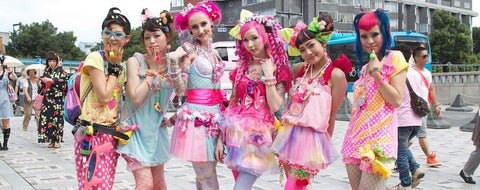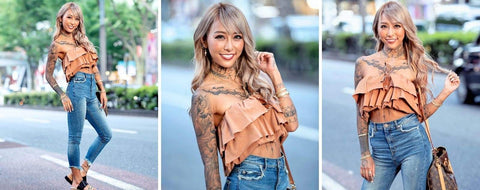Your Cart is Empty
⌛ TODAY FREE WORLDWIDE SHIPPING

You don't have to be a fan of anime and manga to appreciate the wildly colorful kawaii clothes that Japan is famous for, the Harajuku and Shibuya districts in particular, draw large crowds and are known to be the kawaii fashion and trend capitals.

The Harajuku style brings together dozens of different styles (sweet lolita, gothic lolita, Japanese punk style and streetwear style), each more eccentric than the last. He appeared in the early 1980s and became known in the West in the 2000s.
This Japanese street and its surroundings are filled with shopping malls and Japanese clothing chains. This nerve center of Asian fashion welcomes thousands of shoppers, fashion influencers and customers every day of the year to shop and follow the Japanese fashion trend ...
This emblematic place continually generates new fashion trends linked to the concept of Kawaii. Harajuku fashion is imaginative, so much so that it can sometimes seem eccentric to older generations. But freely incorporating one's own tastes is exactly the spirit of the Harajuku style.
Harajuku, being a district of Tokyo, it has its own range of street wear and kawaii categories. The most notable and well-known style among them is the Lolita style. This is what people most expect when looking for "Harajuku Girls". Cute prints on their clothes, long curly hair, big eyes are an integral part of the look.
In order to better understand the concept of the harajuku style we will see in this article:
Japanese fashion is one of the most influential in the world, and this is partly due to its history ... In the 1980s, designers like Kohji Kamamoto and Issey Miyake left their mark on the fashion world.
Today, international brands continue to draw inspiration from it through clothing collections steeped in Japanese culture. We think in particular of the famous:
The combination of traditional Japanese clothing can be seen mixing with the modernism of current streetwear trends. The creators Jean Paul Gautier or the late Karl Lagerfield have perfectly mixed Japanese kimono with Western outfits! Nowadays all the world youth want to have their own identity and choose their style and colors. This is why in Tokyo you will find this unisex Harajuku Streetwear style in all the streets.
Takeshita Street is where everything happens in Harajuku. Whether you just want to take a short stroll to see all the playful wonders, bite into a giant, globe-sized rainbow cotton candy, food and fashion go hand in hand.

There are many features of this harajuku style to make you more crazy. You have to mix styles and different fashion trends. The origin of this Japanese style comes from young girls who mixed their kimono or yukata, their Japanese Geta sandals, and all types of Japanese accessories with all the other types of Japanese clothes in their wardrobe! These Harajuku girls also started mixing Gothic style with Japanese school uniforms for example. You can see this kind of outfit worn by the Japanese group Babymetal which mixes traditional Japanese masks with harajuku kimono!
The main characteristics are in summary:
Streetwear Style

To have a streetwear style, we advise you to wear a printed or embroidered hoodies with a Japanese symbol that you will find in your Japanese temple.
Japanese culture is very rich, you can opt for:
Wear your hoodie with a nice color reminder with a nice pair of sneakers
Lolita style
There are several styles within the Japanese Lolita street style itself. Generally speaking, Lolitas dress like dolls, very feminine with bright colors, frilly dresses, lace and lots of accessories, always with the aim of being pretty and "kawai". . Be prepared to see plenty of them on your travels in Tokyo or other major cities.
There are several Lolita styles that give a lot of charm such as the sweet lolita or the gothic lolita.

The Sweet Lolita style focuses on all aspects related to the child. It uses light or pastel colors.The favorite themes are sweets, Alice in Wonderland and fairy tales to make the girl wearing it look like a little girl.

The gothic lolita style consists of wearing feminine and elegant clothes all with gothic clothes. The preferred colors are black and white. This style is sometimes close to some cosplay inspired by Japanese maids that can be seen in Japanese manga. For goth Lolita clothes we advise you to add frills and lace at the sleeves. The quilts will give your style the finishing touch. Choose as few colors as possible and the same goes for your hair color. Black is ideal for giving this sexy style to Japan
Decora style

For this colorful Japanese style, we must favor prints and bright colors. Japanese girls who embrace this style add accessories and little details from head to toe. You can wear colorful belts or flashy colored Japanese jewelry. Decorate your clothes with toys and plastic jewelry. This style mixes a childish style with today's fashion.
Cosplay style

Cosplay is a Japanese street dress fashion also widespread throughout the world, especially in Europe and North America. It is about playing a manga or cartoon character by adopting his outfit but also by appropriating his poses, his movements and his body expressions.
Cosplay is a real Japanese fashion, used frequently in festivals where everyone takes on the personality and celebrity disguise of the manga.
Gyaru style

This brand was very popular in 1970 but reached its peak in the 2000s. This term was used to designate a group of people, especially women, with little interest in maraige and work. They are also commonly called "kogyaru", which infantilizes this type of person a little more. The Gyaru style is a visual style that is intended to be as close as possible to fashion, so that you can easily find stores everywhere that offer the latest clothes and accessories.
Punk style

The Japanese punk style is Inspired by the punk movement itself which started in London in the 1970s. This style highlights the desire for rebellion and the fact of wanting to break the codes of standard fashion. To properly adopt this style, do not hesitate to wear jeans with holes, frayed denim mini shorts, sleeveless clothes. Complete your Japanese outfit with Japanese accessories like pins, stickers or patches. You can also add nails or spikes to your clothes. In terms of materials, black leather should be favored for a rock metal effect.Also add some piercings and black makeup to push the crazy punkimachine style.
Visual Kei style

This "movement", arose in the 1980s thanks to xJapan, a very popular group in Japan, even the most popular who are now considered the founders of Visual Kei, they brought something new to Japan that was before a very traditional country (and which still is of course) with the risk of being misjudged by the mentalities of the time. It boils down to a very extravagant dress and hair style and extremely working makeup.
The characteristics of this style are as follows:
Bosozoku Style

It was a movement of bikers and young delinquents that proliferated in the 1970s. Sukeban members were girl gangs who were also part of the Bosozoku clans. The bosozoku could be recognized by their reckless motorbike driving and a particular style of dress. They wear a hachimaki. It is a long coat illustrating many kanji on the back. The bosozoku girl wear a Japanese school uniform.